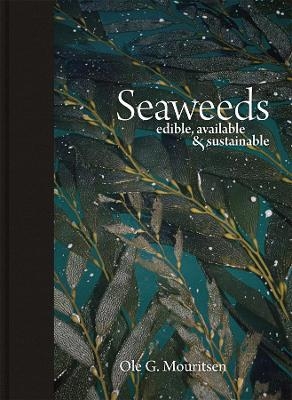
Seaweeds
Edible, Available, and Sustainable
Seiten
2013
University of Chicago Press (Verlag)
978-0-226-04436-1 (ISBN)
University of Chicago Press (Verlag)
978-0-226-04436-1 (ISBN)
- Titel ist leider vergriffen;
keine Neuauflage - Artikel merken
Until recently, seaweed for most Americans was nothing but a nuisance, clinging to us as we swim in the ocean and stinking up the beach as it rots in the sun. This book takes the reader on a tour of seaweed, describing what seaweeds actually are - algae, not plants - and how people of different cultures have utilized them since prehistoric times.
Until recently, seaweed for most Americans was nothing but a nuisance, clinging to us as we swim in the ocean and stinking up the beach as it rots in the sun. With the ever-growing popularity of sushi restaurants across the country, however, seaweed is becoming a substantial part of our total food intake. And even as we dine with delight on maki, miso soup, and seaweed salads, very few of us have any idea of the nutritional value of seaweed. Here celebrated scientist Ole G. Mouritsen, drawing on his fascination with and enthusiasm for Japanese cuisine, champions seaweed as a staple food while explaining its biology, ecology, cultural history, and gastronomy. Mouritsen takes readers on a comprehensive tour of seaweed, describing what seaweeds actually are - algae, not plants - and how people of different cultures have utilized them since prehistoric times for a whole array of purposes - as food and fodder, for the production of salt, in medicine and cosmetics, as fertilizer, in construction, and for a number of industrial end uses, to name just a few.
He reveals the vast abundance of minerals, trace elements, proteins, vitamins, dietary fiber, and precious polyunsaturated fatty acids found in seaweeds, and provides instructions and recipes on how to prepare a variety of dishes that incorporate raw and processed seaweeds. Approaching the subject from not only a gastronomic but also a scientific point of view, Mouritsen sets out to examine the past and present uses of this sustainable resource, keeping in mind how it could be exploited for the future. Because seaweeds can be cultivated in large quantities in the ocean in highly sustainable ways, they are ideal for battling hunger and obesity alike. With hundreds of delectable illustrations depicting the wealth of species, colors, and shapes of seaweed, "Seaweeds: Edible, Available, and Sustainable" makes a strong case for granting these "vegetables from the sea" a prominent place in our kitchens.
Until recently, seaweed for most Americans was nothing but a nuisance, clinging to us as we swim in the ocean and stinking up the beach as it rots in the sun. With the ever-growing popularity of sushi restaurants across the country, however, seaweed is becoming a substantial part of our total food intake. And even as we dine with delight on maki, miso soup, and seaweed salads, very few of us have any idea of the nutritional value of seaweed. Here celebrated scientist Ole G. Mouritsen, drawing on his fascination with and enthusiasm for Japanese cuisine, champions seaweed as a staple food while explaining its biology, ecology, cultural history, and gastronomy. Mouritsen takes readers on a comprehensive tour of seaweed, describing what seaweeds actually are - algae, not plants - and how people of different cultures have utilized them since prehistoric times for a whole array of purposes - as food and fodder, for the production of salt, in medicine and cosmetics, as fertilizer, in construction, and for a number of industrial end uses, to name just a few.
He reveals the vast abundance of minerals, trace elements, proteins, vitamins, dietary fiber, and precious polyunsaturated fatty acids found in seaweeds, and provides instructions and recipes on how to prepare a variety of dishes that incorporate raw and processed seaweeds. Approaching the subject from not only a gastronomic but also a scientific point of view, Mouritsen sets out to examine the past and present uses of this sustainable resource, keeping in mind how it could be exploited for the future. Because seaweeds can be cultivated in large quantities in the ocean in highly sustainable ways, they are ideal for battling hunger and obesity alike. With hundreds of delectable illustrations depicting the wealth of species, colors, and shapes of seaweed, "Seaweeds: Edible, Available, and Sustainable" makes a strong case for granting these "vegetables from the sea" a prominent place in our kitchens.
Ole G. Mouritsen is professor of biophysics at the University of Southern Denmark. His previous books include Life-As a Matter of Fat and Sushi: Food for the Eye, the Body and the Soul. Mariela Johansen holds an MA in history and language. She lives in Vancouver.
| Mitarbeit |
Kameramann: Jonas Drotner Mouritsen |
|---|---|
| Übersetzer | Mariela Johansen |
| Sprache | englisch |
| Maße | 20 x 27 mm |
| Gewicht | 1191 g |
| Themenwelt | Naturwissenschaften ► Biologie ► Botanik |
| Naturwissenschaften ► Biologie ► Limnologie / Meeresbiologie | |
| ISBN-10 | 0-226-04436-X / 022604436X |
| ISBN-13 | 978-0-226-04436-1 / 9780226044361 |
| Zustand | Neuware |
| Haben Sie eine Frage zum Produkt? |
Mehr entdecken
aus dem Bereich
aus dem Bereich
Gefäßpflanzen: Grundband
Buch | Hardcover (2021)
Springer Spektrum (Verlag)
44,99 €
ein Baum erzählt seine erstaunliche Geschichte
Buch | Hardcover (2024)
Ludwig (Verlag)
23,00 €


